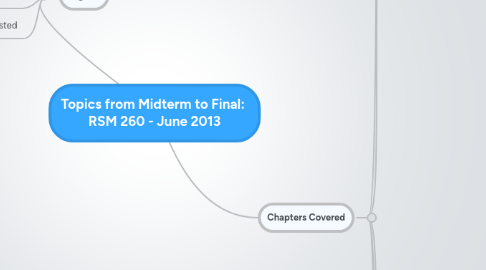
1. Chapters Covered
1.1. Chapter 6 - Motivation in Practice
1.1.1. Money as a Motivator
1.1.1.1. Linking Pay to Performance on Production Jobs
1.1.1.2. Potential problems with Wage Incentives
1.1.1.2.1. Lowered Quality
1.1.1.2.2. Differential Opportunity
1.1.1.2.3. Reduced Cooperation
1.1.1.2.4. Incompatible Job Design
1.1.1.2.5. Restriction of Productivity
1.1.1.3. Linking Pay to Performance on White-Collar Jobs
1.1.1.3.1. Potential Problems with Merit Pay Plans
1.1.1.4. Using Pay to Motivate Teamwork
1.1.1.4.1. Profit Sharing
1.1.1.4.2. Employee Stock Ownership Plans
1.1.1.4.3. Gainsharing
1.1.1.4.4. Skill-Based Pay
1.1.2. Job Design as a Motivator
1.1.2.1. Traditional Views of Job Design
1.1.2.2. Job Scope and Motivation
1.1.2.3. Job Characteristic Model
1.1.2.3.1. Core Job Characteristics
1.1.2.3.2. Critical Psychological States
1.1.2.3.3. Moderators
1.1.2.3.4. Research evidence
1.1.2.4. Job Enrichment
1.1.2.4.1. Potential Problems with Job Enrichment
1.1.2.5. New Developments in Job Design
1.1.2.5.1. Work Design
1.1.2.5.2. Relational Job Design
1.1.2.6. Everything after this in the chapter will not be covered (p. 211-226)
1.2. Chapter 9: Leadership
1.2.1. What is Leadership?
1.2.2. Are leaders born? The trait theory of leadership
1.2.2.1. Research on leadership traits
1.2.2.2. Limitations of the trait approach
1.2.3. The Behaviour of Leaders
1.2.3.1. Consideration and Initiating structure
1.2.3.2. The consequences of consideration and structure
1.2.3.3. Leader reward and punishment behaviour
1.2.4. Situational Tehories of Leadership
1.2.4.1. Fielder's Contingency Theory and Cognitive Resource Theory
1.2.4.1.1. Research evidence
1.2.4.2. House's Path-Goal Theory
1.2.4.2.1. The theory
1.2.4.2.2. Leader Behaviour
1.2.4.2.3. Situational Factors
1.2.4.2.4. Research Evidence
1.2.5. Participative Leadership: Involving Employees in Decisions
1.2.5.1. What is Participation?
1.2.5.2. Potential Advantages of Participative Leadership
1.2.5.2.1. Motivation
1.2.5.2.2. Quality
1.2.5.2.3. Acceptance
1.2.5.3. Potential Problems of Participative Leadership
1.2.5.3.1. Time and Energy
1.2.5.3.2. Loss of Power
1.2.5.3.3. Lack of Receptivity or knowledge
1.2.6. The four types of leadership explored in class during the crane making exercise
1.2.7. Vroom and Jago's Situational Model of Participation
1.2.8. Leader-Member Exchange Theory
1.2.8.1. Research Evidence
1.2.9. Transactional and Transformational Leadership Theory
1.2.9.1. Intellectual Stimulation
1.2.9.2. Individualized Consideration
1.2.9.3. Inspirational Motivation
1.2.9.4. Charisma
1.2.9.5. Research Evidence
1.2.10. None of the content from page 320 to the end of the chapter will be covered.
1.3. Chapter 11: Decision Making
1.3.1. What is Decision Making
1.3.1.1. Well-Structured Problems
1.3.1.2. Ill-Structured Problems
1.3.2. The Complete Decision Maker - A Rational Decision Making Model
1.3.2.1. Perfect versus Bounded Rationality
1.3.2.2. Problem Identification and Framing
1.3.2.2.1. Information Search
1.3.2.2.2. Alternative Development, Evaluation and Choice
1.3.2.2.3. Risky Business
1.3.2.2.4. Solution Implementation
1.3.2.2.5. Solution Evaluation
1.3.2.2.6. Justification
1.3.2.2.7. Hindsight
1.3.2.2.8. How Emotion and Mood Affect Decision Making
1.3.2.2.9. Rational Decision Making - A Summary
1.3.2.3. Group Decision Making: Content from here (p. 400) to the end of the chapter (p. 417) will not be covered.
1.3.3. Anything on the lecture slides is fair game
1.4. Chapter 12: Power, Politics and Ethics
1.4.1. What is Power?
1.4.1.1. Textbook's definition, which I don't like
1.4.1.2. The definition which I prefer (see slides)
1.4.2. The bases of individual power
1.4.2.1. Legitimate Power
1.4.2.2. Reward Power
1.4.2.3. Coercive Power
1.4.2.4. Referent Power
1.4.2.5. Expert Power
1.4.3. How do people obtain power?
1.4.3.1. Doing the right things
1.4.3.1.1. Extraordinary activities
1.4.3.1.2. Visible activities
1.4.3.1.3. Relevant activities
1.4.3.2. Cultivating the right people
1.4.3.2.1. Outsiders
1.4.3.2.2. Subordinates
1.4.3.2.3. Peers
1.4.3.2.4. Superiors
1.4.4. Empowerment - putting power where it is needed This is not covered (p 424 - 427)
1.4.5. Influence Tactics - Putting Power to Work
1.4.6. Who Wants Power
1.4.7. Controlling Strategic Contingencies - How Subunits Obtain Power This section is not covered - p 429 to p. 437
1.4.8. Ethics in Organizations
1.4.8.1. The Nature of Ethical Dilemmas
1.4.8.2. Causes of Unethical Behaviour
1.4.8.2.1. Gain
1.4.8.2.2. Role Conflict
1.4.8.2.3. Strong Organizational Identification
1.4.8.2.4. Competition
1.4.8.2.5. Personality
1.4.8.2.6. Organizational and Industry Culture
1.4.9. P. 442 onward will not be covered on the exam
1.5. Chapter 13 - Conflict and Stress
1.5.1. P. 454 - 459 will not be covered on exam
1.5.2. Managing Conflict with Negotiation
1.5.2.1. Distributive Negotiation Tactics
1.5.2.1.1. Threats and Promises
1.5.2.1.2. Firmness vs Concessions
1.5.2.1.3. Persuasion
1.5.2.2. Integrative Negotiation Tactics
1.5.2.2.1. Copious Information Exchange
1.5.2.2.2. Framing Differences as Opportunities
1.5.2.2.3. Cutting Costs
1.5.2.2.4. Increasing Resources
1.5.2.2.5. Introducing Superordinate Goals
1.5.3. Third Party Involvement P. 463 onward will not be covered on the exam
1.5.4. Everything else on the lecture slides is fair game
